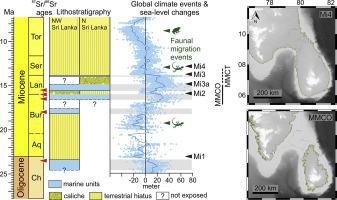Gondwana Research ( IF 7.2 ) Pub Date : 2021-01-01 , DOI: 10.1016/j.gr.2020.12.014 M. Reuter , M. Harzhauser , W.E. Piller

|
As part of the Western Ghats-Sri Lanka biodiversity hotspot, Sri Lanka harbors a rich and diverse fauna with a considerable number of endemic species, especially in the wet southwestern part of the island. Understanding the origin of this biodiversity requires consideration of the land bridge history between the island and southern Peninsular India. To examine the influence of fluctuating sea levels and climate on island connectivity and isolation during the Miocene, we describe the lithological succession of the Jaffna Limestone in surface outcrops of north(west)ern Sri Lanka and interpret it with respect to palaeoenvironments and sequence stratigraphy. A stack of three marine intervals was identified, which were deposited in seagrass-, coral reef-, and nearshore siliciclastic environments of a land-attached carbonate platform and are separated by caliche and palaeokarst unconformities. They represent high sea-level peaks during the long-term sea-level maximum related to the Middle Miocene Climate Optimum (MMCO). In support of divergence time from Sri Lankan and south Indian species, it is argued that the Palk Isthmus connected Sri Lanka to mainland India prior the MMCO (~17–15 Ma) and after the Middle Miocene Climate Transition (~15–13 Ma), whereas a marine barrier continued to persist during low sea-level stands associated with the Mi2, Mi3a and Mi3 glaciations within this period of time. The early and middle Miocene landbridge connections opened up dispersal opportunities for terrestrial animals. Species migrations via the Palk Isthmus were, however, impacted by a climatic filter, which promoted a high level of ancient endemism on Sri Lanka. Our results indicate that the Sri Lankan sub-center of biodiversity started to evolve in response to increased sea-level and climate variability associated with Antarctic ice dynamics and the initiation of the South Asian monsoon system during the early stage of the current ice house period.
中文翻译:

海平面和气候变化在斯里兰卡生物多样性大会中的作用:中新世贾夫纳石灰石的视角
作为西高止山脉-斯里兰卡生物多样性热点的一部分,斯里兰卡拥有丰富多样的动物区系,其中有相当数量的特有物种,特别是在该岛的西南部。要了解这种生物多样性的起源,就需要考虑该岛与印度半岛南部之间的陆桥历史。为了研究中新世期间海平面和气候变化对岛屿连通性和孤立性的影响,我们描述了斯里兰卡西北(西北)地表露头的贾夫纳石灰岩的岩性演替,并就古环境和层序地层学进行了解释。确定了三个海洋间隔的堆栈,它们分别沉积在海草,珊瑚礁,和陆地附着的碳酸盐台地的近岸硅质碎屑环境,并被古迹和古岩溶不整合所分隔。它们代表与中新世中期最佳气候(MMCO)有关的长期海平面最大值期间的高海平面峰值。为了支持斯里兰卡和南印度物种的发散时间,有人认为,Palk地峡在MMCO(〜17-15 Ma)之前和中新世中期气候过渡(〜15-13 Ma)之后将斯里兰卡与印度大陆连接起来。 ,而在这段时间内与Mi2,Mi3a和Mi3冰川相关的低海平面看台上,海洋屏障继续存在。中新世早期和中期的陆桥连接为陆生动物提供了扩散的机会。但是,通过Palk峡峡进行的物种迁移受到了气候过滤器的影响,从而在斯里兰卡促进了古代地方特有主义的发展。我们的结果表明,在当前冰屋期的早期,斯里兰卡的生物多样性分中心开始响应与南极冰动力学相关的海平面和气候变化以及南亚季风系统的启动而发生变化。











































 京公网安备 11010802027423号
京公网安备 11010802027423号